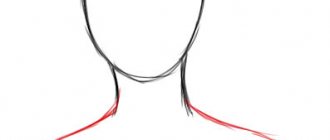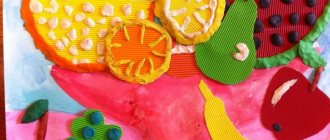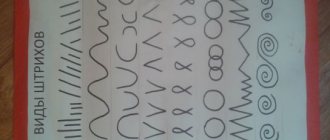GCD tasks and required materials
The purpose of this lesson is to develop the skills of reproducing flower images on paper and teach the basics of composition.
Tasks:
- Educational: teach the correct arrangement of objects on a sheet, build a composition using different elements.
- Educational: to cultivate love for mother, accuracy in work, patience and perseverance.
- Developmental: develop imaginative thinking, eye, aesthetic qualities, train fine motor skills.
Drawing of tulips for the spring holiday
Equipment and materials: landscape sheet, simple pencil, eraser, brushes, paints (watercolors are recommended, but gouache can also be used), a jar for water, napkins, cotton swabs, photographs of flowers and bouquets (tulips, roses, mimosa).
Handouts: album sheets, oval templates for those who find it difficult to draw them.
Audio recording: P. I. Tchaikovsky “Waltz of the Flowers”, “Dance of the Sugar Plum Fairy”.
Drawing lesson “Flowers as a gift for mom”
Svetlana Strunnikova
Drawing lesson “Flowers as a gift for mom”
Lesson on painting with gouache paints “ Flowers as a gift for mom ” in the middle group.
Make you want to draw as a gift for mom on March 8th .
Continue learning to draw flowers (corolla of bright petals, stem, leaves)
.Continue to practice
drawing with gouache paints . Develop a sense of shape and color . Cultivate a caring attitude towards parents, a desire to please with homemade gifts .
Practical part of the lesson, drawing a beautiful bouquet
During the lesson they draw a bouquet of flowers to give to their mother. Such lessons are defined as “direct educational activities” (DEA).
GCD progress, what techniques can be used to apply an image
For depictions, children can use gouache drawing with a brush, as well as using their fingers and palms for this.
Introductory part
At the beginning of the lesson, the teacher reads a riddle poem to the children about how spring comes to replace winter. They answer that this happens in the spring.
The teacher asks about what holiday is happening at this time. Children talk about Mother's Day - March 8th. The teacher recites a poem about this holiday, then asks what can be given to mom on this day.
After discussing with the kids, they come to the conclusion that the best gift would be a beautiful bouquet of flowers. Then the children are shown illustrations with flowers prepared in advance.
There is a discussion about what parts plants have. They talk about leaves, stems, petals, their shape and color.
Physical education minute
Then the teacher offers to get up and rest a little using the so-called physical education minute. Music sounds, and children make certain movements to the poems.
“Chamomile, chamomile (children shake their heads) / Fragrant flower. / Yellow heart (springs) / White petal / With cold and wind (hands up, swaying) / The rains came again / And in the garden, like in summer (lean forward, holding hands to the sides) / Asters bloomed. / We are red carnations (the kids are marching), / Satin petals, / Slender legs (we hold our hands on our belts and stand on our heels), / Green boots.”
Main part
Children are asked to sit down and start drawing.
The teacher, together with the kids, repeats what flowers have (stems, leaves, flower petals). Discuss their color and shape.
Drawing flowers is done in different ways: some paint with a brush. Others use fingers and palms.
The kids make drawings for mommy on their own. The teacher watches how they act and helps with advice.
Then he looks at the resulting images of flowers, discusses and praises the kids.
Children draw
Lesson Objectives
The tasks that the teacher must complete when conducting a lesson for the middle group “Drawing flowers for mom” are divided into several groups.
Some of them relate to the development of various skills and knowledge. Others help shape personality. Still others promote intellectual and aesthetic development.
Developmental and educational
When conducting a lesson, it is important to ensure that the following tasks are completed:
- Children must master the drawing techniques used in class. It is necessary to consolidate knowledge and skills and develop them.
- Children's perception of beauty and sense of composition improves.
- The development of fine motor skills plays an important role in this.
- Cultivating hard work and accuracy.
Note! The lesson is complex in nature, it is intended for simultaneous completion of several tasks
Practical part of the lesson
It consists of three stages.
Bouquet sketch
The teacher hands out album sheets, suggests placing them vertically in front of you and starting to sketch flowers for mom. The tulip has an oblong bud, so you need to draw three uneven ovals with a simple pencil at the top of the leaf. If it is difficult for your child to do this, you can invite him to circle the finished template. Then draw the petals at the top of the bud, carefully erase the excess lines with an eraser so as not to damage the paper.
Lesson on fairy tales for younger groups of kindergartens - what to read
The teacher helps the children draw pencil lines for the stems from the buds down so that they intersect at the bottom to form a bouquet. Then you need to add long leaves to each stem, outlining elongated arcs on the side with a pencil.
Important! The teacher should check each child's drawing for accuracy, make sure that the flowers are located in the upper part, the stems intersect at one point, the leaves are elongated, and if necessary, make edits with your own hand so that the sketch looks compositionally correct.
Drawing a bouquet
The teacher talks to the children about the rules of working with paints, how to hold a brush, and remove excess water. It should remind you that tulips come in red shades. The student should be taught to put red or crimson paint on a brush and carefully paint over the plant without going beyond the outline. The middle tulip needs to be highlighted with a different tone of paint. You can take a darker burgundy color and draw flower petals.
Drawing a tulip
Then you should rinse the brush and take a dark green color, draw the middle line of the stem and paint on each elongated leaf. You need to apply the paint thickly, do not smudge it too much with water, and make sure it doesn’t spread. The teacher must monitor the correct performance of the work, help overcome difficulties that arise, and use napkins if there is a lot of water in the drawing.
Note! You need to make sure that the child touches the paper with the bristles of the brush, and not with a wooden stick, and squeezes the brush out of the water on the edge of the jar.
When the bouquet is ready, you can decorate it with ribbons, numbers and adding mimosa.
Bouquet decoration
As an option, you can beautifully tie a bouquet of tulips with a ribbon. Children can choose the color of the future bow themselves. You need to draw an uneven square at the bottom, at the intersection of the stems, and next to it on the right and left, draw two triangles, rounding the edges. This way you will get a beautiful bow. From below you need to draw two curved lines with a brush, similar to ribbons.
Drawing a bow
If children want to add a sprig of mimosa to the bouquet, they can take a cotton swab, soak it in water, dip it in yellow paint and place several round prints near each tulip at the top. These little yellow circles will resemble mimosa flowers.
Drawing lessons in preparatory groups
If the drawing is being prepared for the holiday of March 8, then you can draw a beautiful figure eight and circle it with paint, or prepare a template with the corresponding number in advance to attach it to the right place on the sheet and circle it.
Finishing the mimosa
Important! All works should be collected and arranged into an exhibition of drawings.
As the task progresses, the teacher monitors the correct observance of all stages and provides assistance in the form of recommendations and practical hand movements. He monitors the accuracy of the work and the correct application of paint, and helps children if the paint has spread or gone beyond the outline of the drawing.






